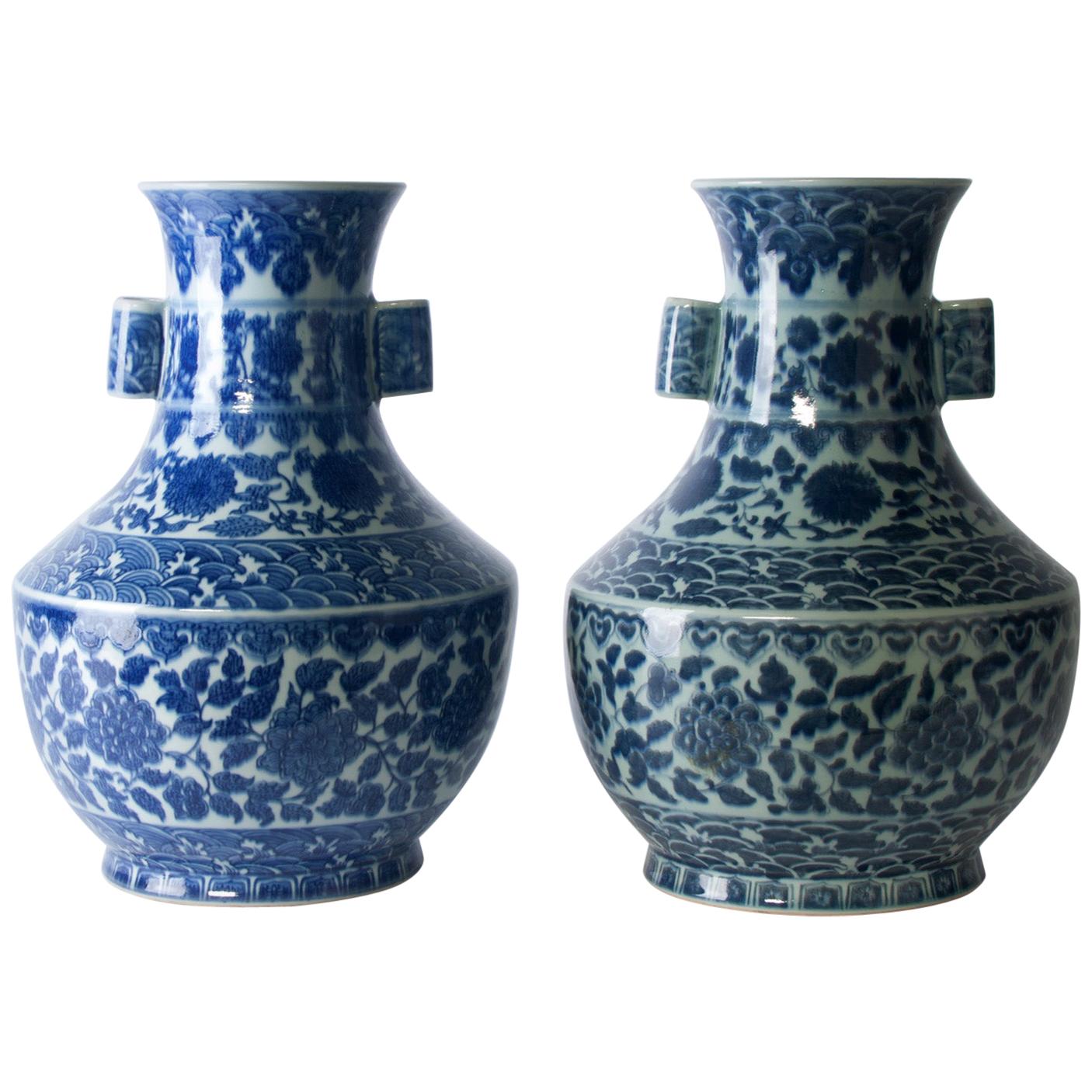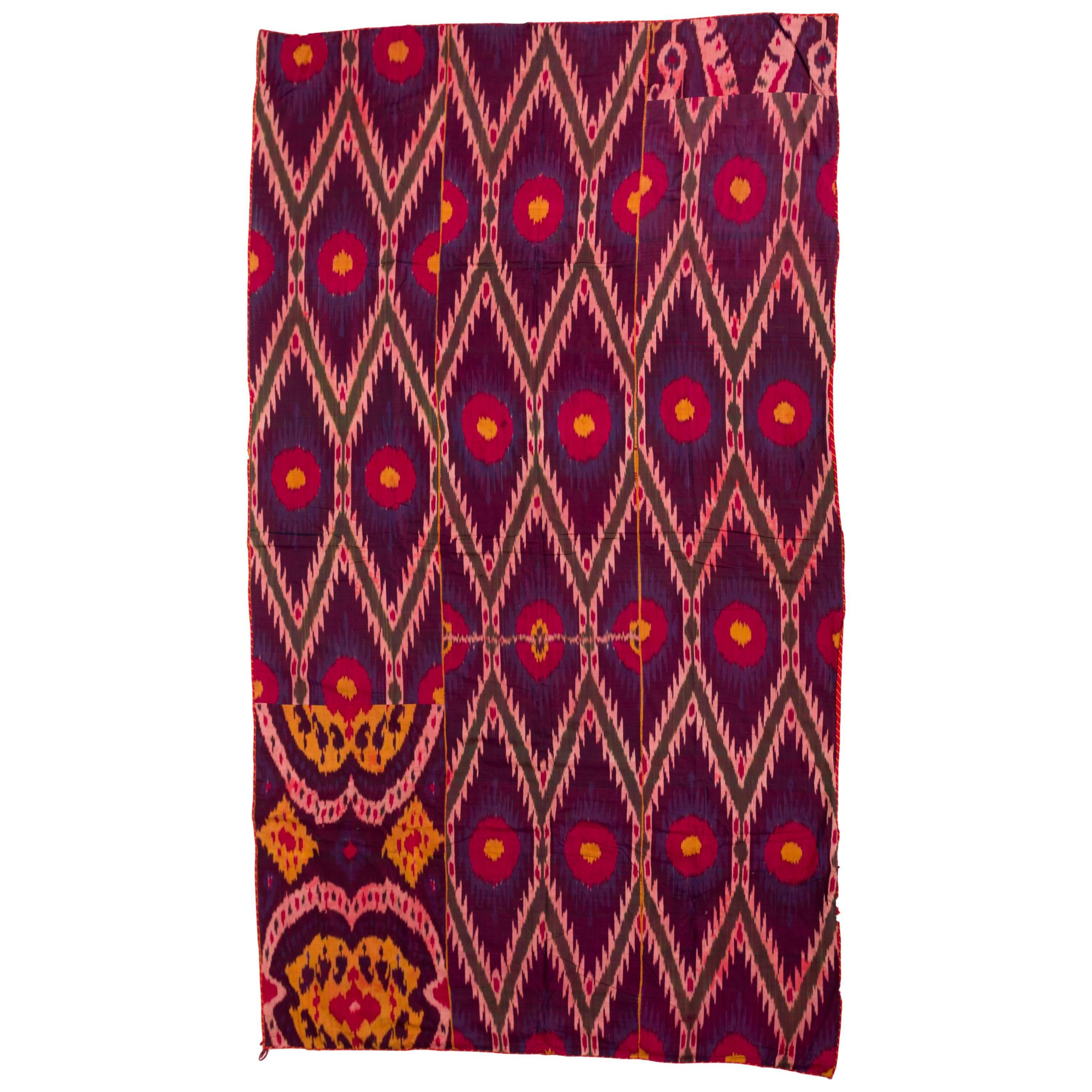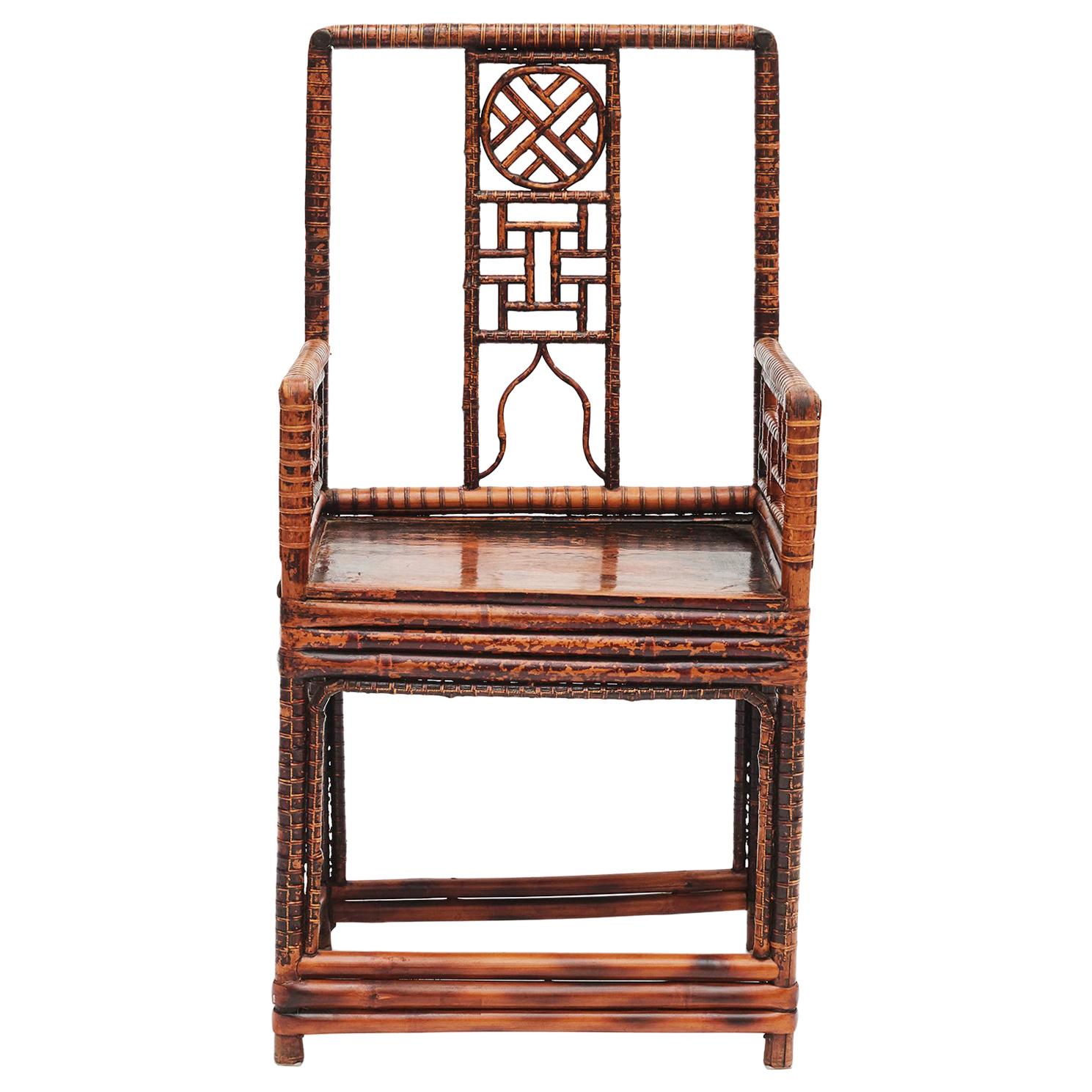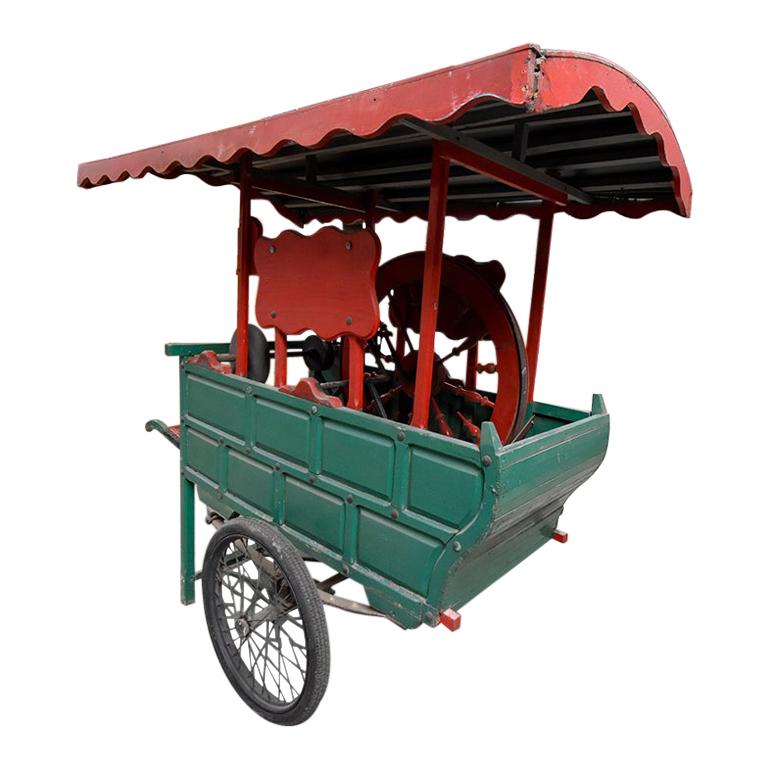Items Similar to Beautiful Ikat Munisak, Uzbekistan, 19th Century
Want more images or videos?
Request additional images or videos from the seller
1 of 5
Beautiful Ikat Munisak, Uzbekistan, 19th Century
About the Item
A beautiful Ikat Munisak – a woman’s uzbek robe – in traditional pomegranate design symbolizing fertility. It has a square patch in Magenta with a flower motif.
Ca. 19th Century
Ikat weaving has emerged from different parts of the world independently, however it is ikat from Uzbekistan, defined as abrabandi, meaning “bound cloud” which is the most captivating. The word ‘ikat’ comes from the Malaysian word ‘mengikat’ or ‘to tie’, because the loose threads are tied into bundles using grasses or wax-treated cotton to specify where the dye is able to sink in and color the thread. The threads are dyed before they are woven into the textiles.
A characteristic of ikat textiles is an apparent “blurriness” to the design. The blurriness is a result of the extreme difficulty the weaver has lining up the dyed yarns so that the pattern comes out perfectly in the finished cloth. The blurriness can be reduced by using finer yarns or by the skill of the craftsperson. Ikats with little blurriness, multiple colours and complicated patterns are more difficult to create and therefore often more expensive. However, the blurriness that is so characteristic of ikat is often prized by textile collectors.
The Silk Road was a network rather than a single highway, at the heart of which sat what we know today as Uzbekistan, where mountain and steppe meet desert. A succession of empires lost and won by nomadic invaders have left behind a unique melting pot of cultures. Merchants, pilgrims, and envoys were attracted here, not only by trade but also by exchanges in religion, technology and the arts. Where these people met, so too did their ideas and their creativity, one of the most original and visually dramatic examples of Central Asian silk.
The clarity, saturation and depth of colour in classical ikats are their greatest artistic strengths. The eye is teased, tickled by the sophistication of the composition and the elegance of the forms. Viewers may become lost in an ikat’s intertwining motifs, but it is colour that truly entrances them. Each unique ikat is the work of an individual who thought deeply about his every choice of colour and form in order to build a harmonious composition. There is always a concern with negative and positive space, for the placement of each pattern and its corollary. We can see the risks that the anonymous ikat designers took and trace their response to each step of the dyeing process. In their way, each ikat is a discovery of a new kind of order.
Measurements: 122 x 117 cm.
- Dimensions:Height: 46.063 in (117 cm)Width: 48.032 in (122 cm)Depth: 1 in (2.54 cm)
- Materials and Techniques:
- Place of Origin:
- Period:
- Date of Manufacture:19th Century
- Condition:
- Seller Location:San Pedro Garza Garcia, MX
- Reference Number:
About the Seller
3.7
Vetted Seller
These experienced sellers undergo a comprehensive evaluation by our team of in-house experts.
1stDibs seller since 2017
22 sales on 1stDibs
Typical response time: 18 hours
- ShippingRetrieving quote...Ships From: San Pedro Garza Garcia, Mexico
- Return PolicyA return for this item may be initiated within 3 days of delivery.
More From This SellerView All
- Ikat Chyrpy, Central AsiaLocated in San Pedro Garza Garcia, Nuevo LeonSpectacular hand-loomed Chyrpy with a checkered pattern, finished with a remarkable white wavy cotton edging. Women in Uzbekistan and Northern Afghanistan wore this outdoor veiling g...Category
Antique 15th Century and Earlier Asian Antiquities
MaterialsCotton
- Ikat Chyrpy, Central AsiaLocated in San Pedro Garza Garcia, Nuevo LeonStriking hand-woven chyrpy with a checkered triangle pattern in vibrant colours. Women in Uzbekistan and Northern Afghanistan wore this outdoor veiling garment (paranja/chrypy) in tr...Category
Antique 15th Century and Earlier Asian Antiquities
MaterialsCotton
- Magnificent Silk Ikat Chapan, Uzbekistan, Xix CenturyLocated in San Pedro Garza Garcia, Nuevo LeonIkat Chapan – a man’s uzbek coat – Style Robe with exceptionally rich colour and dynamic pattering. Viewers may become lost in this ikat’s intertwining mot...Category
Antique 15th Century and Earlier Uzbek Antiquities
MaterialsCotton
- Monumental "Bigger Than Life Size" Wooden BodhisattvaLocated in San Pedro Garza Garcia, Nuevo LeonImposing figure of Bodhisattva sitting in a royal pose with a beautiful serene expression, with semi close eyes expressing beatitude, in very well carved robes and pearl strings on t...Category
Antique Late 17th Century Chinese Antiquities
MaterialsWood
- Monumental Han Dynasty Terracotta Horse - TL Tested - China, '206 BC–220 AD'Located in San Pedro Garza Garcia, Nuevo LeonA massive pottery horse with separately made head and tail, standing on all fours and striding with its right hoof forward. Extended snout ends in parted lips showing teeth beneath i...Category
Antique 15th Century and Earlier Chinese Han Antiquities
MaterialsTerracotta
- Eastern Han Dynasty Terracotta Model of a Paper Mill , China '206BC - 220AD'Located in San Pedro Garza Garcia, Nuevo LeonSlab pottery constructed Model of a Paper Mill, in Green and Cream Color Glazed Terracotta having a peaked roof – open walled form with a mechanical pounder and a large round storage container. Light blue-green mottled glazed surface with some iridescence patina to the glaze. The Iridescence is a refraction of the layers on the glass that produces multicolor hues & metallic luster, and only develops after one thousand years of being buried in the ground. An unquestionable mark of antiquity, impossible to falsify. Han Dynasty, dated 206 B.C-220 A.D. Condition: Excellent, wear commensurate with age, an unusual example. This fantastic piece is accompanied by a Certificate of Authenticity. Sculptural effigies of domesticated animals were often interred in the tombs of nobility and elite members of the social hierarchy. Models like this one were made to represent everything from simple goat or pig pens to the most elaborate towers and palaces. Because very few ancient Chinese buildings have survived intact, these models, along with descriptions from ancient texts, give a good representation of what the buildings might have looked like. Burial figurines of graceful dancers, mystical beasts, and everyday objects reveal both how people in early China approached death and how they lived. Since people viewed the afterlife as an extension of worldly life, these figurines, called mingqi, sometimes referred as “spirit utensils” or “vessels of ghosts” disclose details of routine existence and provide insights into belief systems over a thousand-year period. For the first time in Chinese history, we have images of rural and daily life during the Han in the form of contemporary records...Category
Antique 15th Century and Earlier Chinese Han Antiquities
MaterialsTerracotta
You May Also Like
- Antique Ikat Dyed Uzbek Silk RobeLocated in Delray Beach, FLBeautiful bright and colorful Antique Ikat silk Dyed Uzbek Robe. Has minor wear and tear shown in photos. Colors: Fuchsia, light pink, purple, yellow and bl...Category
Vintage 1920s Uzbek Textiles
MaterialsSilk, Cotton
- 19th Century Mongolian ChestLocated in New York, NY19th century Mongolian painted chest. Wonderful papered inside with old calligraphy paper. Nice as a hall chest, or as display table. Exceptional piece. Cab be used for storage, an...Category
Antique 19th Century Mongolian Antiquities
MaterialsPaper, Wood
- 19th Century Chinese VasesLocated in Esbeek, NLBeautiful 19th century vases.Category
Antique Late 19th Century Chinese Vases
MaterialsPorcelain
- Late 19th Century Uzbekistan Tribal Silk Ikat PanelLocated in New York, NYLate 19th century silk tribal Ikat weaving panel from Uzbekistan, Central Asia. Luxurious over saturated magenta, purple, gold, green and pink. Reverse s...Category
Antique Late 19th Century Uzbek Tribal Tapestries
MaterialsSilk
- 19th Century Chinese Bamboo ArmchairLocated in Kastrup, DK19th century Chinese bamboo armchair with a plain flat wooden seat. China, circa 1840. Good quality and craftsmanship.Category
Antique Mid-19th Century Chinese Qing Armchairs
MaterialsBamboo, Wood
- Antique Knife Sharpener, 19th CenturyLocated in Udenhout, NLA beautiful antique knife sharpener from the 19th century, comes from France, from a mansion near to Paris. A real unique item.Category
Antique Mid-19th Century French Antiquities
MaterialsWood
Recently Viewed
View AllMore Ways To Browse
19th Century Cotton
19th Century Furnitures With Designers
Asian Designer
Asian Cloud
Asian Antique Arts
Asian Woman
Asian Woman Art
Pomegranate Design
Uzbekistan Art
Ikat Design
Cotton Ikat
Antique Ikat
19th Century Central Asian Uzbek
Pilgrim Century
Antique Art Exchange
Antique And Art Exchange
Century Furniture Silk Road
Pilgrim Furniture





